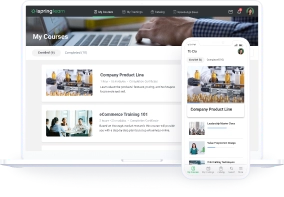How to Build a Learning Culture that Drives Business Forward

As today’s business environment continues to evolve at breakneck speed, prioritizing continuous employee development is more critical than ever. By creating a culture of learning, organizations ensure their employees have the skills to stay competitive, adapt to changes, and futureproof the business.
With so much at stake, we’ve put together this ultimate guide to building a true learning culture. We’ll take a deep dive into:
- What a learning culture is
- Why it matters
- How to build a culture of continuous learning in your company
- How an LMS can support learning
What Is a Learning Culture in an Organization?
A learning culture is a work environment that encourages and supports learning. As a result, it promotes professional growth and places high value on acquiring new skills and knowledge.
Companies with strong learning cultures empower employees to experiment, risk taking, and learn from their mistakes. Moreover, they provide opportunities for staff to learn from each other, share knowledge, and collaborate.
Here’s what Robert J Grossman, Professor of Management Studies in the US, said about the strong learning culture in a piece for the Society for Human Resource Management: “A learning culture consists of a community of workers instilled with a growth mindset. People not only want to learn and apply what they’ve learned to help their organization, they also feel compelled to share their knowledge with others.”
Why Is a Learning Culture Important?
From staff retention rates to the bottom line, implementing an organization’s culture of learning and development impacts companies in a number of ways. We’ve listed the key benefits of learning cultures below.
- Enhanced employee engagement: True learning cultures allow employees to learn and grow, leading to a more engaged and committed workforce.
- Better job satisfaction: Learning opportunities help staff feel more fulfilled in their roles, boosting job satisfaction and employee retention rates.
- Better overall performance: Equipping workers with the skills to do their jobs effectively results in higher productivity and incomes.
- More adaptability: Continuous learning arms staff with the tools needed to adapt to market conditions and customer needs, and helps companies stay competitive.
- Improved employer branding: Employees value development opportunities highly, so companies that provide them are better able to attract and retain top talent.
How to Build a Learning Culture: 12 Strategies that Work
In this section, we offer some actionable tips and tricks on how to build strong learning cultures that drive organization’s success and growth.
Tip 1: Survey the current training landscape
Start by conducting thorough research to assess how employees currently learn in your company. This includes gathering employee feedback, holding sessions with managers and other stakeholders, and reviewing all training activities.
Use this research to pinpoint the strengths and weaknesses in your current learning processes, and then define a business strategy.
Tip 2: Create a learning framework
Creating a clear framework will help staff navigate and take ownership of their development journey. This includes establishing a clear career development roadmap, a competency framework, and a checklist of the skills each employee must have for their current and future roles.
These frameworks can inform managers when it comes to creating individual talent development plans for employees.
Tip 3: Set the tone right from the beginning
Employee onboarding is an opportunity to initiate new hires into the organization’s learning culture right away. So, make sure your new employee onboarding includes not only such important things as organizational values, attitudes, and behaviors, but also a detailed overview of your company’s learning culture, opportunities, and expectations. The sooner they adapt to the culture, the sooner they’ll start reaping the rewards.
Also read: New Employee Onboarding 101 – Set New Hires Up for Success from Day 1
Tip 4: Make learning accessible
To make organizational learning cultures really stick, you have to remove common learning barriers. These include:
- Lack of awareness: Employees don’t know training exists or where to find it.
- Ineffective delivery methods: Staff can’t easily access training.
- Long processes: Ineffective software is making the process of accessing training difficult.
Fortunately, investing in a robust learning management system (LMS) can remove these roadblocks.
An LMS is a platform designed to manage and deliver employee training. Top LMSs, such as iSpring LMS, host all training content under one roof and streamline the learner experience.
Here are just some ways an LMS makes organizational learning accessible.
- Creates a single knowledge hub with unlimited access for employees 24/7
- Lets employees learn anytime, anywhere, right on their mobile devices
- Provides learners with interactive content they will really enjoy
- Facilitates social learning and sharing of knowledge
Tip 5: Personalize learning
Effective employees learning behaviors are formed better if employees see the impact of learning on their own performance or productivity. As such, tailoring training to their individual roles, experience, and needs is an excellent way to get them on board.
An LMS allows managers and training teams to build personalized learning paths that engage and empower individual team members to reach their goals. In short, tailoring learning shows staff what’s in it for them, boosting participation and motivation.
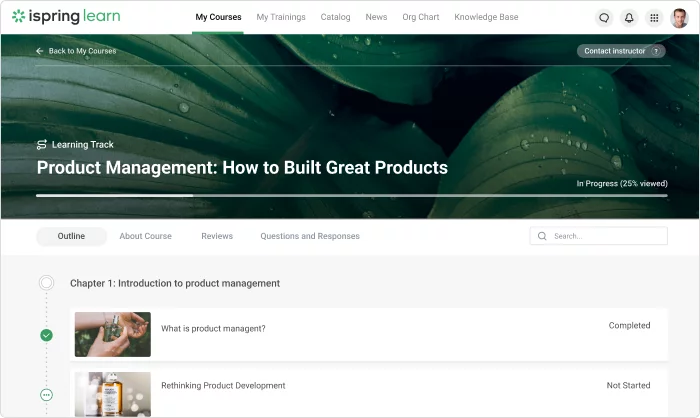
Tip 6: Facilitate sharing of knowledge
Not all workplace learning occurs during formal training sessions. Much of it happens through social learning and knowledge sharing. Therefore, encouraging peer-to-peer learning can distill a culture of continuous education in your company.
Your LMS can help you here. Social learning features allow employees to share learning resources with their peers, discuss training topics, and make learning a part of their daily lives. From asking SMEs questions to sharing industry-related articles or videos with their teams, sharing of knowledge embeds learning in your organization’s ecosystem.
Moreover, leveraging sharing of knowledge takes the pressure off L&D teams to provide continuous training. Instead, people learn from each other, are responsible for their own development, and actively seek learning opportunities.
Tip 7: Provide employees with engaging content
Solid learning cultures engages employees and makes training fun. To achieve this, you need to develop compelling content that’s relevant to your workforce’s needs and interests. An authoring tool is the best way to do this.
A content authoring tool allows you to create interactive eLearning content: online courses, microlearning modules, interactive quizzes, etc. These resources can then be uploaded to an LMS and shared across your organization.
iSpring Suite is an ideal solution for in-house learning content creation, with rich features to build one-of-a-kind training that aligns with your organizational business goals and needs. Moreover, its simple PowerPoint design means you can build professional-grade courses with no previous experience.
iSpring Suite
Fully-stocked eLearning authoring toolkit for PowerPoint. No training required to start!
Here are some ideas of the types of learning content you can build with iSpring Suite:
Slide courses
Slide-based courses are visually appealing and easy to navigate. Plus, you can incorporate text, images, and multimedia elements to cater to different types of learners.
One of the unique features of iSpring Suite is Character Builder, which allows you to enhance your slides with beautiful pre-designed and customizable characters. They’re great if you want to add a personal touch to your learning content by incorporating an instructor, trainer, or a “colleague” who accompanies and supports the learner during the course. You can change their skin color and hairstyle, and choose accessories, appropriate clothing, and a relevant pose. It only takes a few minutes, but can help make your content truly immersive.
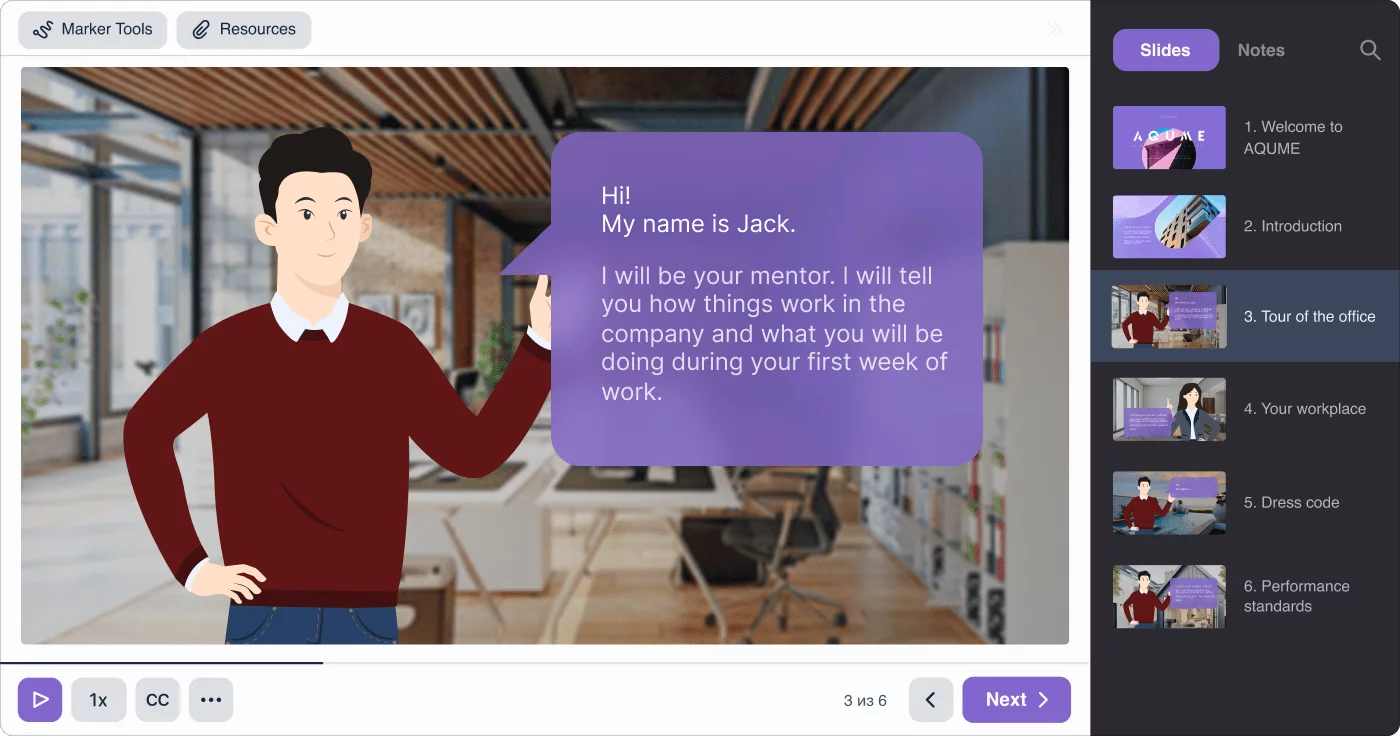
Interactive quizzes and assessments
Quizzes are a fun and engaging way to test employees’ knowledge and identify skills gaps. Moreover, they’re quick to build and can be used as a standalone refresher or as part of an online course.
iSpring Suite has 14 ready-made question templates so you can build engaging quizzes in next to no time. Plus, you can add media and set up branching and customizable testing rules to personalize your quizzes and amp up engagement.
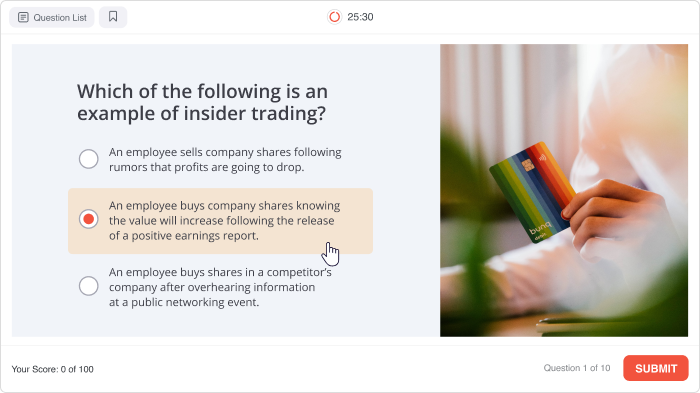
Role-play simulations
Role-plays are a highly effective way to train vital soft skills like communication. They simulate real-life scenarios, allow employees to build new skills in a risk-free environment, and provide real-time feedback to guide learners.
With iSpring Suite, you can create engaging role-plays that target real-life problems. In addition, the built-in character library and locations make the process both quick and easy.

eLearning interactions
Microlearning breaks complex information down into bite-sized chunks, making it easier for employees to interact with and digest the new knowledge. eLearning interactions, such as interactive timelines, FAQs, and diagrams, are perfect for presenting microlearning modules.
With 14 pre-built templates in iSpring Suite, you can build engaging and professional-looking learning content quickly. These interactions can be used as standalone content or combined to create a comprehensive online course.
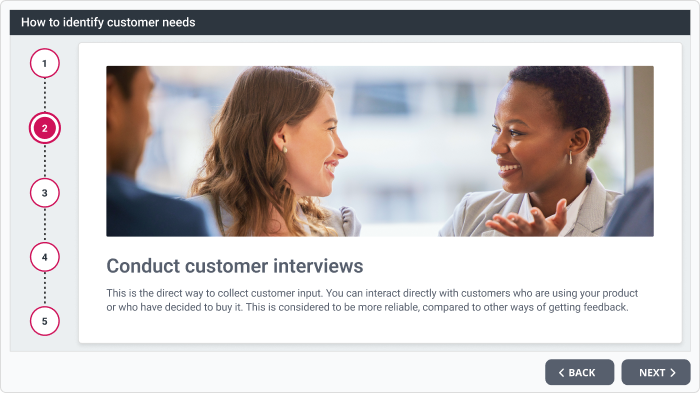
Tip 8: Make learning fun
Dull, dry training is a death knell for any budding knowledge culture. Luckily, gamification is an excellent hack for getting employees motivated and engaged in learning. It’s also perfect for rewarding employees who are actively participating in learning activities.
For example, at iSpring, we have gamification built into our LMS. This makes it easy to liven up training sessions by rewarding learners with points and badges. You can also create leaderboards to show who’s engaged in the training and who’s falling behind.
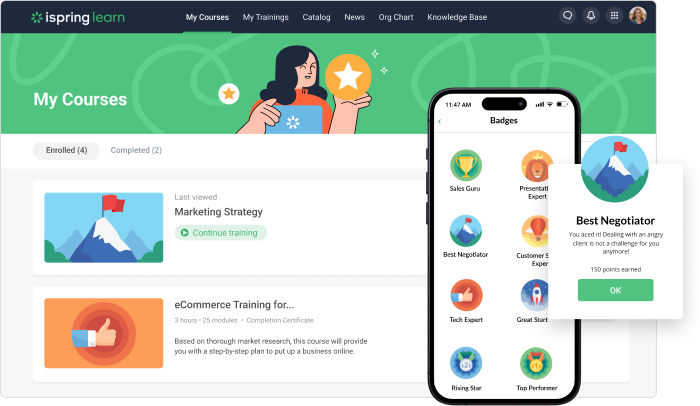
Of course, it’s not just about points and badges. Incorporating creative storytelling into training is another way to sidestep formal learning and create a fun learning environment. Whether it’s building entertaining plot twists through branching scenarios, interactive quizzes, or role-play simulations, adding a splash of fun to training will work wonders in terms of enhancing learner engagement and retention.
Tip 9: Provide continuous training
Ideally, you want employees to embrace learning as a core principle and a continuous process in the company. The best way to achieve this is by providing ongoing training opportunities like online courses, entire development programs, workshops, and sharing of knowledge through an LMS.
With an LMS, L&D teams can automate training management tasks like enrolling employees in courses, sending notifications about new learning programs and their deadlines, and tracking learner progress and results. As a result, your company can provide continuous development in a way that’s sustainable.
Also read: Automated Training – Free Up Your Team to Focus on More Meaningful Tasks
Tip 10: Promote a learning culture
A lack of awareness can dampen your efforts to build a culture of knowledge. So, unleash your inner influencer and start promoting a learning culture at your company. Here are some ways to get the message out there.
- Spread awareness: Collaborate with managers to help spread the word, hold info sessions, promote the learning strategy behind using corporate communication tools, and start an email campaign to share news, expectations, and tips.
- Highlight the benefits: During your awareness campaign, be sure to communicate the why behind building a culture of learning and what’s in it for employees.
- Create policies and processes: Formalizing L&D processes and policies, and sharing them with employees builds awareness and integrates learning into your company core.
- Think outside the box: Introduce learning initiatives like lunch and learns, designated development days, learning communities, and after-action reviews.
Tip 11: Foster a feedback culture
Feedback is integral to an effective learning culture. So, it’s important to encourage employees to share their feedback on the overall learning experience in your organization. These insights will give you valuable ideas on how you can optimize your learning culture strategy and where you’re getting it right.
The best ways to gather this constructive feedback are through surveys (these can be delivered within your LMS), informal sessions, and one-on-one meetings with managers.
There’s another added benefit of fostering a feedback culture: you’ll create a sense of community and collaboration within the business, uniting staff with a shared learning goal of driving personal and professional development.
Tip 12. Measure the results and tweak your strategy
Rome wasn’t built in a day, and neither is a learning culture. It takes time to foster a culture of continuous development and some tweaks along the way. That’s where a robust LMS will come in handy again.
LMS analytics and reporting allow you to measure the results of your training initiatives. That way, you can see what’s working and what’s not. For instance, with iSpring LMS, you can pull reports to check how many employees have taken an online course, who passed the assessment, and who isn’t participating in the training. Then, you can use this data to make any needed changes to your learning strategy.
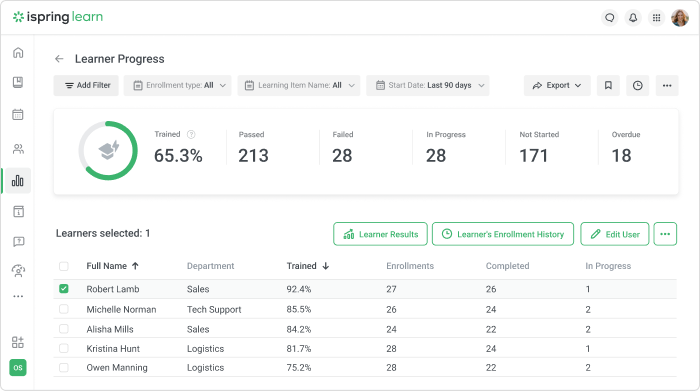
Monitoring assessment results in your LMS is also an excellent way to identify gaps in your training. What information or skills training do employees need and don’t currently have? Are many employees getting a specific answer wrong? This could indicate a knowledge gap or that your learning materials need to be improved.
The bottom line is that regularly measuring the impact of learning activities in your organization will help you see what you’re doing right and where improvements are needed.
FAQ
Here we answer your burning questions about using an LMS in the process of building a strong learning culture.
1. What is an LMS and how can it help create a learning culture?
A Learning Management System (LMS) is a platform used to manage, deliver, and track organizational training activities. By using a learning portal, companies can provide employees with a host of learning courses and resources, including personalized learning paths and on-demand modules. This encourages employees to take control of their professional growth and development.
Since most LMSs are mobile-friendly, learning can happen at any time and location. As a result, it provides a flexible, accessible, and engaging way to provide employees with ongoing training.
2. How can organizations encourage employees to use an LMS?
Since most of the top LMSs are intuitive and user-friendly, encouraging employees to start using one shouldn’t be too difficult. Company leaders should start by communicating the value of learning and explaining the role that a learning platform plays in the process. Next, management should lead by example and use the LMS themselves, sharing their experience, insights, and activities with the workforce.
Finally, organizations can offer incentives and rewards to motivate employees to participate. For example, badges, points, or certifications can be awarded to employees who use the LMS. Some take this a step further, offering promotions, bonuses, or other financial incentives to employees who complete certain training courses or certifications.
3. What are some best practices when implementing an LMS and creating a learning culture?
While each organization is different, there are some golden rules to follow when leveraging an LMS to create an effective learning culture that supports and benefits the business and workers alike.
Also read: 12 LMS Benefits For Recruiters, HR, Sales and Commercial Directors—Expert Opinion
- Set clear learning objectives and align them with organizational business goals
- Use a variety of training content formats (videos, images, audio, etc.) to cater to different learning styles
- Create opportunities for peer-to-peer learning and collaboration through cross-team projects and workshops
- Use LMS reporting to measure the results of your training initiatives and identify knowledge gaps
- Gather employee feedback regularly and adjust learning strategies accordingly
4. What are the 3 basics of learning culture?
- Continuous Learning : This involves a dedicated commitment to ongoing skill development, ensuring individuals stay abreast of the latest industry advancements.
- Sharing of Knowledge : Fostering an environment where individuals freely exchange insights, experiences, and expertise, thereby enriching the collective learning experience.
- Growth Mindset : Cultivating a learning mindset that embraces challenges, values effort, and perceives failures as valuable opportunities for learning and improvement. Together, these three basics lay the groundwork for a dynamic and thriving learning culture within any organization.
5. What is an example of a learning culture?
In an exemplary learning culture, employees actively participate in professional development initiatives, seizing opportunities for skill enhancement through workshops and courses. This culture fosters regular knowledge-sharing sessions, whether through scheduled meetings, forums, or digital platforms, facilitating the exchange of ideas and insights. Emphasizing open communication and constructive feedback, employees view feedback as a valuable tool for learning and improvement.
Collaboration is not just encouraged but valued, with teamwork and joint projects providing fertile ground for shared learning experiences. Additionally, the entire organization acknowledges and rewards individuals or teams for their dedication to learning, innovation, and contributions to the collective knowledge pool. In essence, this learning culture places a premium on continuous improvement, adaptability, and the collective growth of its workforce.
Final Thoughts
Creating a learning culture in your business is the key to longevity. At the employee level, it equips them with the soft and hard skills they need to grow, also boosting engagement, performance, and loyalty.
As an employer, a culture of learning garners better business results, reduced staff turnover, and increased productivity. Moreover, it fosters innovation, encouraging employees to solve future business problems.
Using a powerful LMS like iSpring LMS can help you not just implement a learning culture, but embrace it as a core value in your organization. But don’t take our word for it — see for yourself by signing up for a free iSpring LMS demo today.
Want to build your own compelling learning materials? Take iSpring Suite for a test drive with a 14-day trial with the full-featured tool.
